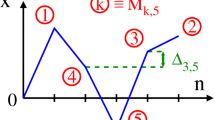Abstract
We study three different random walk models on several two-dimensional lattices by Monte Carlo simulations. One is the usual nearest neighbor random walk. Another is the nearest neighbor random walk which is not allowed to backtrack. The final model is the smart kinetic walk. For all three of these models the distribution of the point where the walk exits a simply connected domain D in the plane converges weakly to harmonic measure on \(\partial D\) as the lattice spacing \(\delta \rightarrow 0\). Let \(\omega (0,\cdot ;D)\) be harmonic measure for D, and let \(\omega _\delta (0,\cdot ;D)\) be the discrete harmonic measure for one of the random walk models. Our definition of the random walk models is unusual in that we average over the orientation of the lattice with respect to the domain. We are interested in the limit of \((\omega _\delta (0,\cdot ;D)- \omega (0,\cdot ;D))/\delta \). Our Monte Carlo simulations of the three models lead to the conjecture that this limit equals \(c_{M,L} \, \rho _D(z)\) times Lebesgue measure with respect to arc length along the boundary, where the function \(\rho _D(z)\) depends on the domain, but not on the model or lattice, and the constant \(c_{M,L}\) depends on the model and on the lattice, but not on the domain. So there is a form of universality for this first order correction. We also give an explicit formula for the conjectured density \(\rho _D\).












Similar content being viewed by others
References
Camia, F., Newman, C.M.: Critical percolation exploration path and SLE\(_6\): a proof of convergence. Probab. Theory Relat. Fields 139, 473–519 (2007). arXiv:math/0605035 [math.PR]
Fitzner, R., van der Hofstad, R.: Non-backtracking random walk. J. Stat. Phys. 150, 264–284 (2013). arXiv:1212.6390 [math.PR]
Jiang, J.: Exploration processes and SLE\(_6\). Preprint (2014). arXiv:1409.6834 [math.PR]
Jiang, J., Kennedy, T.: The difference between a discrete and continuous harmonic measure. J. Theoret. Probab. (to appear). arXiv:1506.04313 [math.PR]
Kennedy, T.: The smart kinetic self-avoiding walk and Schramm–Loewner evolution. J. Stat. Phys. 160, 302–320 (2015). arXiv:1408.6714 [math.PR]
Knabner, P., Angermann, L.: Numerical methods for elliptic and parabolic partial differential equations. Texts Appl. Math. 44, Springer, New York (2003)
Kremer, K., Lyklema, J.W.: Indefinitely growing self-avoiding walk. Phys. Rev. Lett. 54, 267 (1985)
Lawler, G.F., Limic, V.: Random Walk: A Modern Introduction. Cambridge University Press, Cambridge (2010)
Smirnov, S.: Critical percolation in the plane: Conformal invariance, Cardy’s formula, scaling limits. C. R. Math. Acad. Sci. Paris 333, 239–244 (2001). arXiv:0909.4499 [math.PR]
Weinrib, A., Trugman, S.A.: A new kinetic walk and percolation perimeters. Phys. Rev. B 31, 2993 (1985)
Werner, W.: Lectures on two-dimensional critical percolation, statistical mechanics (IAS/Park City mathematics series v. 16). Sheffield, S., Spencer T. (eds.) (2007). arXiv:0710.0856 [math.PR]
Acknowledgments
This research was partially supported by NSF Grant DMS-1500850. An allocation of computer time from the UA Research Computing High Performance Computing (HPC) and High Throughput Computing (HTC) at the University of Arizona is gratefully acknowledged. The author thanks Jianping Jiang for many stimulating conversations about this research.
Author information
Authors and Affiliations
Corresponding author
Rights and permissions
About this article
Cite this article
Kennedy, T. The First Order Correction to the Exit Distribution for Some Random Walks. J Stat Phys 164, 174–189 (2016). https://doi.org/10.1007/s10955-016-1534-8
Received:
Accepted:
Published:
Issue Date:
DOI: https://doi.org/10.1007/s10955-016-1534-8



